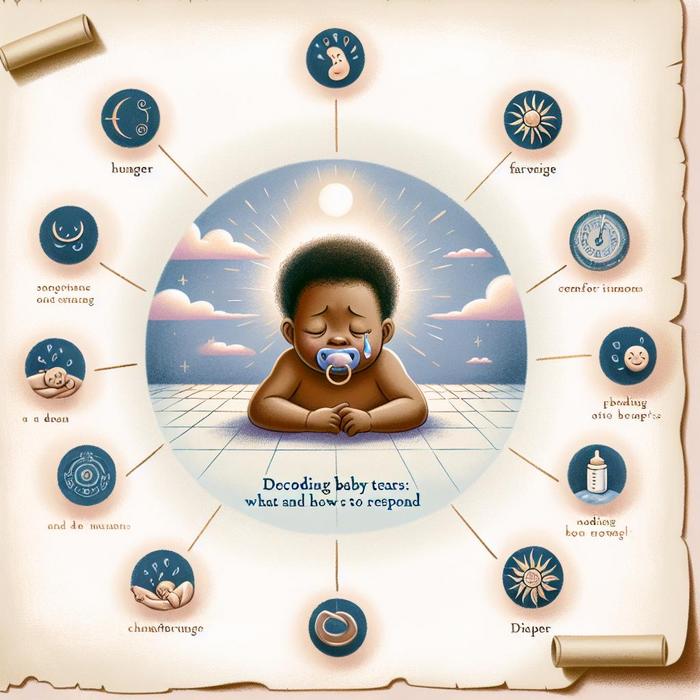Understanding the Language of Baby Tears
As parents, we often find ourselves in a predicament when our beloved little one bursts into tears. Understanding baby crying and deciphering the reasons for baby tears can sometimes feel like a cryptic puzzle. However, knowing that this is just their way of communication can help us approach this situation calmly and effectively.
Why Do Babies Cry?
The first few months of parenting may seem more like a guessing game, as crying is your baby’s primary means of communication. They might be telling you they’re hungry, wet, or just need some attention. According to experts from NCT, some babies cry more than others, but they all do this for a reason. It’s just a matter of understanding what these reasons might be.
Here are some common reasons for baby tears:
- Hunger: This is one of the most common reasons why a newborn cries, especially if they’re not feeding well or often enough.
- Discomfort: An uncomfortable diaper or a tight piece of clothing could be causing your baby discomfort.
- The need for sleep: Your baby may not know how to fall asleep on their own, causing restlessness and crying.
- Need for attention: Babies need a lot of cuddling, comforting, and reassurance to learn about the world around them.
- Colic: Some babies can have periods of intense crying known as colic, which can be difficult to soothe.
When your baby cries, it’s essential to remain patient and calm, responding promptly and effectively to their needs. The NHS suggests holding your baby, speaking softly to them, or gently rocking them to help soothe their crying.
Deciphering the Cry
While it’s true that all babies cry, not all cries are created equal. Different cries can indicate different needs. The Bump offers some insight into different crying sounds and what they might mean. For example, a sharp, intermittent cry could mean your baby is overstimulated, while a high-pitched, continuous wail could indicate pain or discomfort.
As you spend more time with your baby, you’ll start picking up on the subtleties of their cries and understand their needs better. Remember, you’re learning and growing along with your child. Don’t be too hard on yourself if you can’t decode their cries straight away.
Using Tools to Soothe Your Baby
Aside from the traditional methods of rocking, holding, and feeding, there are additional tools at your disposal that can help soothe your crying baby. For instance, the use of baby swings has proven to be a very effective calming tool, offering a gentle and comforting motion that babies find soothing. You can learn more about finding the best baby swing over at Bio-Feeding.
Another effective method of soothing your baby and strengthening your bond is through yoga. Yes, you read that right! Yoga with your baby can be a wonderful way to connect with them on a deeper level, stimulate their senses, and help them feel calm and secure. Learn more about this wonderful practice at Bio-Feeding.
How to Respond to a Crying Baby?
Responding promptly and compassionately is vital when a baby cries. Quick reactions communicate to the baby that their needs will be answered, providing them with a sense of security and trust. Here are a few strategies parents can try:
- Feeding: If your baby fussesand puts their hand to their mouth or makes sucking noises, they might be hungry. Feed them immediately and ensure they’re feeding adequately throughout the day.
- Burping: Every baby is unique, and some may need to burp often to relieve discomfort. After each feeding, hold your baby upright or over your shoulder and gently pat their back to facilitate burping.
- Comforting: Simple yet effective methods, such as holding your baby close, humming or singing to them, and rocking back and forth, can go a long way in comforting them.
- Changing: Keep your baby dry and fresh by regularly checking and changing their diaper. Timely changes prevent skin irritation and discomfort that can lead to crying.
- Swaddling: Swaddling provides babies with a womb-like feeling of comfort, helping them fall asleep faster and stay asleep longer. It’s an effectively tried-and-tested method to quiet a fussy baby.
You needn’t fret if your actions don’t calm your baby immediately. It takes practice, time, and a lot of patience, but eventually, you’ll understand what works best for your little one. Refer to Seattle Children’s Hospital for further guidance on soothing and understanding a crying baby.
When to Seek Professional Help?
Sometimes, despite your best efforts, your baby might continue to cry excessively without an apparent reason. If their crying is persistent or seems to be caused by pain or illness, it might be time to seek professional help. Excessive crying can be a symptom of medical issues, including ear infections or acid reflux. Understanding when to seek professional guidance can save you unnecessary worry and ensure your baby’s well-being.
If you’re ever in doubt about your baby’s health, always consult a healthcare provider. Don’t hesitate to reach out to your pediatrician or turn to resources such as MedlinePlus for further information.
The Emotional Impact on Parents
Caring for a crying baby can be demanding emotionally and physically. It can sometimes cause feelings of helplessness, frustration, or stress among parents. Understanding this emotional impact is crucial, and seeking support if needed is encouraged.
Moreover, remember to take care of yourself. You’re better equipped to soothe a crying baby when you’re relaxed and refreshed. Consistently practice self-care, eat healthily, take breaks when needed, and don’t hesitate to share caregiving responsibilities with family or friends.
Taking care of a newborn is a beautiful journey of bonding and growth. Despite the moments of distress and confusion, comforting a crying baby can lead to deeper connections between you and your little one. In the end, your baby’s well-being depends on how well you understand, interpret, and respond to their needs.
For more tips on understanding and responding to baby crying, you can refer to RaisingChildren and KidsHealth.

